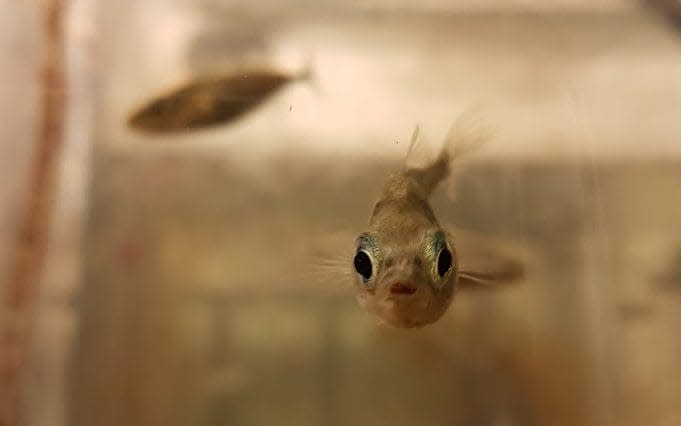There's something about Mary the stickleback: scientists baffled by 'virgin' fish

A ‘virgin’ fish dubbed Mary left scientists baffled after appearing to become pregnant without a mate.
The female stickleback was collected on an expedition to the Outer Hebrides by researchers from the University of Nottingham.
But once in the tank, scientists discovered she was carrying fertilised eggs inside of her, something that has never been seen before in an egg-laying species.
Usually the male stickleback builds a nest and, by performing a zig-zagging dance routine, lures a female to lay her eggs inside it, after which he chases her away and fertilises the cluster.
The protective father then guards the eggs, fanning them with his fins for two weeks until they hatch.
However scientists realised that Mary was carrying fertilised eggs inside her that were ready to hatch, something that would almost certainly have killed her. Instead she was put to sleep and the 54 embryos delivered by Caesarean section.
Dr Laura Dean, from the School of Life Sciences, said: "We were astounded at what we found when we examined Mary in our lab in the Outer Hebrides.
“She looked like an ordinary egg-bound fish so we couldn't believe it when we found she had almost completely developed embryos inside her ovaries.
“This is pretty much unheard of in an egg laying species. The embryos were perfectly healthy, not deformed in any way, and most have gone on to live a normal adult lifespan."

To investigate how the strange pregnancy had occurred, scientists genetically tested the offspring to see if they were clones of the mother, or if Mary was hermaphrodite, carrying both sex organs.
To their surprise they found different versions of genes meaning that a father must have been involved at some point. And the researchers have a strange explanation about what occurred.
Dr Dean said: "Our theory is that somehow sperm had got into the fish, fertilised the eggs and they developed into normal two-parent embryos.
“What has probably happened is that she has gone into a nest to lay her eggs where another female had already laid her eggs which had been covered with sperm by a male stickleback.
“Somehow some of the sperm in the nest must have got into Mary, presumably through her egg tube, and fertilised the eggs inside her but she never laid the eggs."
The finding of fertilised eggs inside a stickleback has only been recorded once before, in a paper published in the 1950s, but it was just recorded as a picture of the fish with no delivery of the embryos.
And scientists believe the odd event could help explain how humans and other mammals eventually evolved to have live young.
Andrew MacColl, Associate Professor of Evolutionary Biology, at the University of Nottingham, said:" Although this almost accidental find revealed a vanishingly rare phenomenon, it might help us to understand a really important change that has happened throughout the tree of life.
“Most animals lay eggs, but some (including almost all mammals, but few fish) retain their eggs inside and give birth to live young.
“Although this appears to be a difficult thing to achieve in evolution, this one little fish seems to have got there almost by itself!"
The research was published in the journal Scientific Reports.

